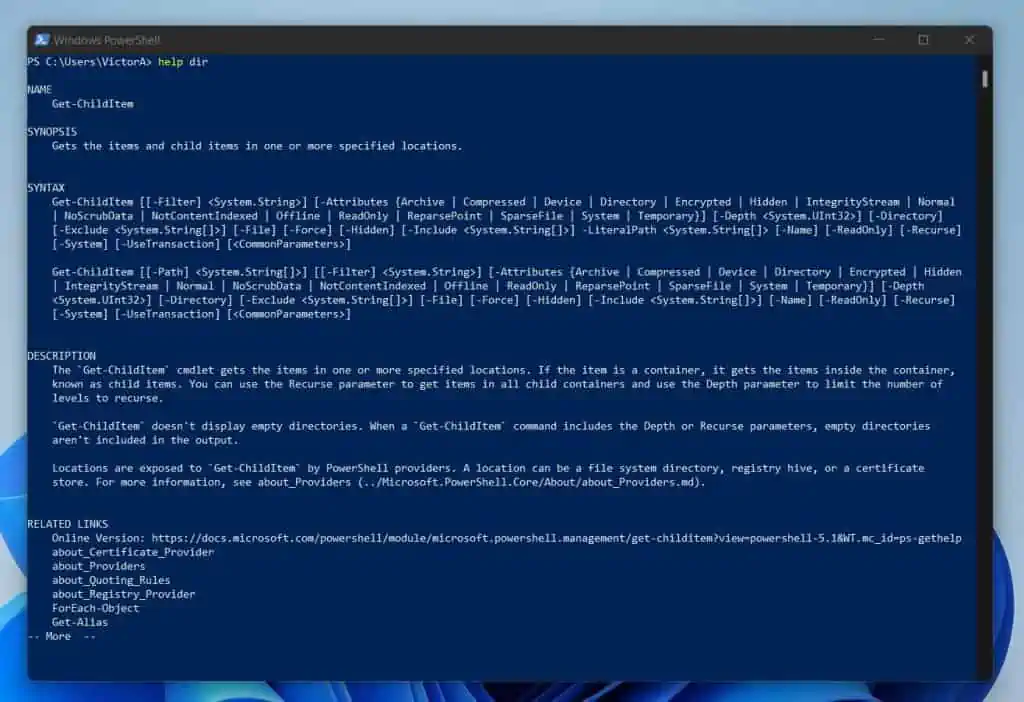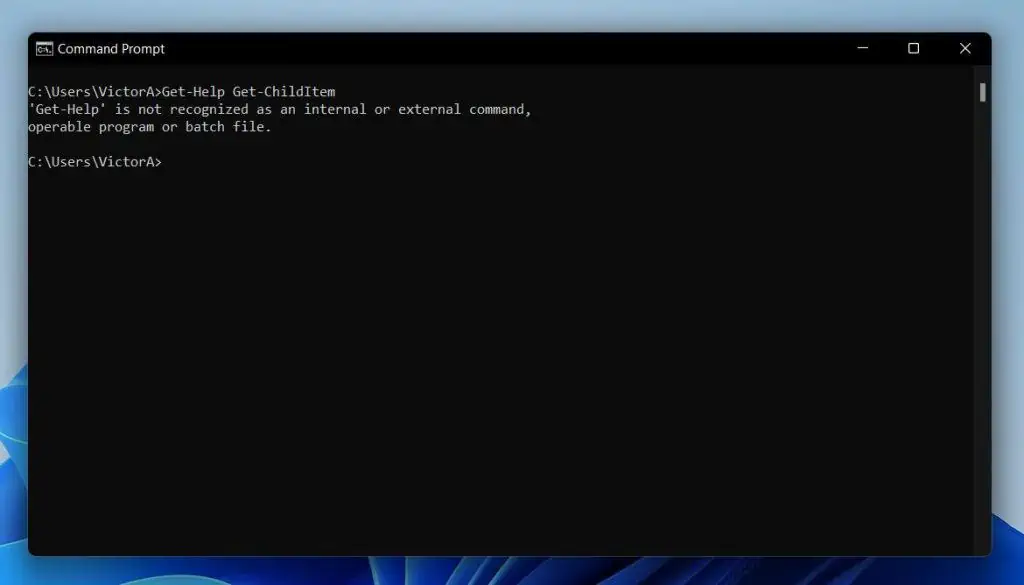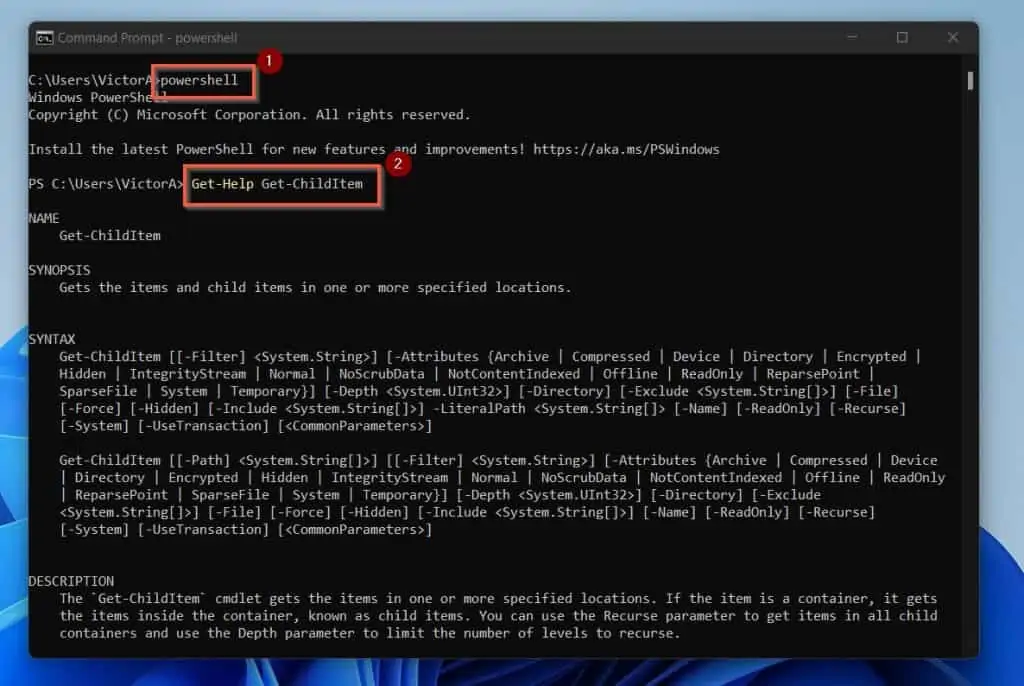Have you heard about Windows PowerShell and want to know why it is better than CMD? Come with me in this Windows PowerShell and CMD comparison guide as I explore both tools.
Overview
Microsoft initiated the idea of task automation by introducing the Command shell. The idea was (and still is) to use the Command shell to automate Windows routine tasks with batch (.bat) files.
Since this first shell was built into Windows, Microsoft has made some attempts to introduce more scripting tools into Windows. Their next attempt at task automation was the introduction of the Windows Script Host engine.
Finally, as recorded by Wikipedia, on November 14, 2006, Microsoft released their best task automation tool yet – Windows PowerShell. Since the release of PowerShell v1, the tool has grown.
PowerShell was first released as a Windows-only scripting task automation tool. However, as of the time I updated this article (July 2022), PowerShell is now a cross-platform tool – it now runs on Windows, Linux, and macOS.
So, why is Windows PowerShell far better than CMD and even the Windows Script Host engine?
That is exactly the question this guide intends to answer!
How Windows PowerShell Works Compared to CMD
Windows PowerShell is a task-based command-line shell and scripting language built on .Net Framework. When Microsoft launched PowerShell in 2006, it was called “Windows PowerShell.”
As I mentioned earlier, at launch (and up till PowerShell v3.0), Microsoft called it “Windows PowerShell.” However, starting from PowerShell 3.0, Microsoft compiled PowerShell on .NET CLR (Common Language Runtime).
Then, Microsoft rebranded the tool as “PowerShell Core.” One reason for changing the name was to demonstrate that it was no longer a Windows-only too.
Rather, from that point, Microsoft made PowerShell open-source. In addition to making it open-source, Microsoft made “PowerShell Core” available in Linux and macOS (and, of course, it is still available on Windows!).
So, how does Windows PowerShell work? You can read how this shell works by visiting the How Windows PowerShell Works (link opens in a new browser tab) section of my Windows PowerShell article.
Moving on to CMD, how does Windows Command Prompt (CMD) work?
Unlike Windows PowerShell and PowerShell Core that Microsoft built on .Net Framework and .NET CLR, respectively, CMD is a native application of the Windows operating system.
The term “native application” implies that CMD is built into the Windows Operating System (OS). Microsoft implemented the command prompt in the Windows OS through the Win32 console.
So, in a Windows OS, the CMD leaves in C:\Windows\system32\cmd.exe. Therefore, when you open a command prompt, you’re effectively calling cmd.exe located in the “\Windows\system32” folder.
CMD is a Windows command line interpreter used to execute CMD commands. In essence, the CMD is a command interpreter that accepts commands from you (the user) and sends them to the OS.
Then, when the cmd receives results from the OS, it displays them for you on the console.
Features Comparision of PowerShell vs CMD
So far, you have read a quick overview of Windows PowerShell vs CMD. You have also seen how these two Windows shells work.
In this section, I will dive deeper by comparing the features of Windows PowerShell vs CMD.
PowerShell Runs on the .Net Framework While CMD Runs on Win32 Console
As I mentioned in this guide more than once, Microsoft built Windows PowerShell on the .Net Framework. On the contrary, the Command Prompt shell is a native Windows application that runs on the Win32 console.
PowerShell Commands Use a Verb-Noun Format, CMD Commands do Not
Another major feature difference between PowerShell and the native Windows Command shell is the way Microsoft formats the commands.
In the first instance, while CMD commands are called “commands”, Windows PowerShell commands are referred to as “CommandLets” (Cmdlets).
Furthermore, one major difference between CMD commands and cmdlets is that PowerShell cmdlets follow a Verb-Noun formant. On the other hand, CMD commands follow a standing one-word naming convention.
For example, the CMD CD (change directory) is called Set-Location (Verb-Noun) in PowerShell (more on this in the third sub-section below).
The CMD “Help” Command is Replaced with “Get-Help” in PowerShell
You access help in PowerShell using the Get-Help Command. In CMD, you use the HELP Command.
This is not surprising since, as you saw above, PowerShell cmdlets follow a Verb-Noun format.
PowerShell Includes the Windows Command Shell Capabilities
PowerShell has all the capabilities of the CMD. However, CMD does not have the capabilities of PowerShell.
This is why you can run CMD commands within PowerShell, but you cannot run PowerShell commands in CMD.
For example, I can run “help dir” in PowerShell, but I cannot run “Get-Help Get-ChildItem” in CMD.


If you want to run PowerShell commands within Command Prompt console, enter powershell into the CMD console and press enter.
After doing that, you can run PowerShell commands in Command Prompt console.

PowerShell Has Equivalent Cmdlets for Some CMD Commands
In the last section, I mentioned that Windows PowerShell has Command Prompt capabilities. This means that PowerShell can run all CMD commands, but *CMD cannot run PowerShell cmdlets.
Based on all I have said in this subsection, you wouldn’t be surprised to learn that PowerShell has equivalent cmdlets for some CMD commands.
If you want to get started with basic PS commands, below I have some common CMD commands and their PowerShell equivalent.
| CMD Command | PowerShell Equivalent | What the commands D |
|---|---|---|
| CD | Set-Location | Change Directory |
| RENAME | Rename-Item | Renames a File |
| DIR | Get-ChildItem | List files and folders in a Directory |
| HELP | *Get-Help | Provides help information |
| FORMAT | Format-Volume | Formats a disk for use with Windows |
| TASKKILL | Stop-Process | terminate a process |
| SHUTDOWN -S | Stop-Computer | Shuts down a local (or remote) computer(s) |
| SHUTDOWN -R | Restart-Computer | Restarts a local (or remote) computer(s) |
Strengths and Weaknesses of PowerShell vs CMD
I suspect that you would have seen some of the strengths and weaknesses of Windows PowerShell vs CMD. However, in this section, I will formally highlight the most prominent pros and limitations of Windows PowerShell vs CMD.
Strengths Comparisons of Command Prompt vs PowerShell
- Windows PowerShell console can run all CMD commands, but CMD console cannot run PowerShell Commands. The most obvious advantage of PowerShell over the native CMD is that CMD cannot run PowerShell commands.
However, PowerShell can run CMD commands. Note that if you first run “powershell”, in CMD, you can run PowerShell cmdlets within the cmd console.
Then, you can run PowerShell cmdlets within CMD. The major difference is that by default, PowerShell runs CMD commands. - PowerShell commands have aliases by default, but CMD commands do not. Microsoft builds aliases into Windows PowerShell.
However, to use aliases in batch files (scripting files for CMD), you have to add the aliases manually. The implication is that there are no universal aliases for CMD commands, unlike PowerShell. - Defining variables is easier in PowerShell compared to batch files. PowerShell variable definition is more robust compared to batch file alias definitions.
For example, in PowerShell, to define a variable called “test,” you enter a dollar sign before the word test ($test). Then, enter the equality sign and the command you want to save in the variable.
Here is an example that saves the result of the Get-ChildItem in a variable called “items”:
$items = Get-ChildItem
PowerShell also has some cmdlets specifically created for manipulating variables. If you want to list these cmdlets, run the command below:
Get-Command *-variable* - Windows PowerShell and CMD batch files support the pipeline character (|). So far, I have been highlighting the benefits of PowerShell that are not available in CMD.
Finally, I can discuss a benefit that is common to both shells – pipeline! Both PowerShell and Command Prompt use the same pipeline character (|).
The benefit of “piping” is that it allows you to use the output of one command as the input of the next command.
Here is an example of a command in CMD:
systeminfo | find “system”
Similarly, you can also use the same pipeline character in a PowerShell command below:
Get-ComputerInfo | Select-Object OsType - Commenting in PowerShell is more robust. If you wish to comment out a line in a batch script, you use either “::” or “REM”.
In the case of PowerShell, you use “#” to add comments. If I stopped here, PowerShell commenting would not have any advantage over CMD batch file commenting.
However, beyond the basic one-liner commenting, PowerShell has an advanced commenting feature where you can add multiple comments.
For example, to add multiple comments to a PowerShell script, I’ll add my comments between <# and #>. Although in CMD batch file scripting, you can use the “GOTO” code to add multiple comment lines; it is not as robust as what PowerShell offers.
Drawbacks of Windows PowerShell vs Command Prompt
- CMD has limited scripting capabilities. Although you can use batch files for scripting in CMD, its capabilities are nowhere near the scripting capabilities of Windows PowerShell.
For example, like CMD, PowerShell has a command-line console. But, beyond the basic command-line console, PowerShell has a dedicated scripting environment known as PowerShell Integrated Scripting Environment (ISE). - Unlike PowerShell, CMD does not have in-built remoting capabilities. Windows PowerShell has in-built remoting capabilities.
In PowerShell, you can use available remoting cmdlets to perform automation tasks on a remote computer.
In addition to these remoting cmdlets, some PowerShell commands also have the “Computer” parameter that allows you to specify a remote computer that a command runs on.
CMD commands do not have these robust remoting capabilities. - PowerShell remoting creates some security concerns. I cannot mention the limitations of Windows PowerShell vs CMD without highlighting the risks PowerShell remoting poses.
Before you can successfully make remote connections via PowerShell, you need to open some ports on the remote computer. Opening these ports increases the remote computer’s vulnerabilities. - CMD does not offer command completion capabilities. One of the big pluses of the PowerShell command shell is that it offers command completion and capabilities.
This feature is not available in CMD or batch file scripting. - You cannot import commands in Windows Command Prompt. In PowerShell, you can import modules and functions from a remote computer.
Once you import these modules, you can run the commands in the modules on the local computer. This capability is not available in CMD.
Frequently Asked Questions
Without any shred of doubt in my mind, the answer is a resounding YES! PowerShell is much better and more robust than CMD.
Here are some of the features PowerShell offers that you don’t get in CMD:
i) PowerShell offers command completion
ii) Windows PowerShell comments are more advanced
iii) Aliases are built into PowerShell cmdlets but not CMD
Yes. You can run all CMD commands in PowerShell, but you cannot run PowerShell cmdlets in CMD except if you first open “powershell.”
I wouldn’t quite describe PowerShell as “coding.” However, PowerShell has a robust scripting engine.
Windows PowerShell has a console, which is referred to as “WIndows Terminal” in Windows 11.
On a basic level, you can run commands in PowerShell to perform Windows tasks instead of using your mouse to perform those tasks.
However, on the advanced level, you can build PowerShell scripts that automate routine Windows tasks.
Conclusion
Windows PowerShell is the new kid in the Microsoft task automation block! It is much more robust than the CMD or even the Windows Script Host.
One of the major differences between Windows PowerShell and CMD is their core building block. While PowerShell is built on the .Net Framework, CMD is is native Windows application built on the Win32 console.
I hope that this article has been able to convince you that Windows PowerShell is better than CMD? I am personally convinced that all Windows SysAdmins should learn PowerShell.
The good news is that it is not as difficult as most SysAdmins think it is. If you found this guide helpful, kindly spare two minutes to share your thoughts using the comments form (“Leave a Reply”) at the bottom of this page.
Alternatively, you can respond to the “Was this page helpful?” question below.
Finally, to learn more about PowerShell, visit our Windows PowerShell Explained page.




Great article, thank you. How does PowerShell run CMD commands within the PowerShell shell? I know that it sometimes invokes a CMD window, but often commands like “cd ” just work in PowerShell. Can you tell us more about how the two are interlinked? Thanks again.
Hi Jon,
Thank you so much for this feedback. It is extremely useful. I have included a new section called “Windows PowerShell vs CMD: Running Commands” – this section answers all the questions you raised. Please go through it and let me know your thoughts.